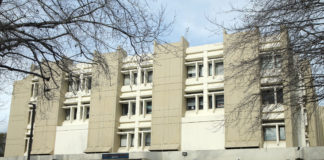
APTOS—A blaze that Aptos/La Selva Fire said was likely started by a homeless person seeking warmth has felled one of the towers that once reached into the sky alongside Highway 1 in Aptos.
The tower was part of a quintet of now-silent radio antennae that stand at the site.
According to Aptos/La Selva Fire Protection Deputy Fire Marshal Marco Mack, the fire damaged the concrete at the base of the tower, and the porcelain insulators there.
The tower fell and then bounced, causing the fire to extend 50 feet into nearby brush. Firefighters quickly extinguished the blaze. There are no witnesses or suspects, Mack said.
Workers erected the first tower at the site in May of 1977, according to John Hibble of the Aptos Chamber of Commerce and the Aptos History Museum.
KKAP-AM, at 1540 on the radio dial, went live in November of 1977.
Wrathall’s plan was to build three, 160-foot-tall antennas on the Cabrillo Golf Course for Cabrillo Broadcasting Company, a daytime-only station that would focus on news, sports and music.
The station designed the towers to look like flagpoles, which was thought to present a more pleasing appearance. They were the only ones of their kind in the country at the time, and were the tallest flagpoles west of the Appalachian Mountains, Hibble said.
In the fall of 1979, the Federal Communications Commission granted approval to increase the station’s power to 10,000 watts, allowing the signal to be heard as far away as King City and Point Sur.
After an additional antenna was installed, the station changed the call letters to KMFO and began broadcasting at 10,000 watts in September 1980. That station shifted to news and information, especially during the morning commute.
In 1984, KMFO adopted a Sunday sports talk program, which soon increased to a daily broadcast. In 1985, the station produced live coverage of the Wharf to Wharf race.
KMFO installed two additional towers to help it shift to a 24-hour format.
The rock and roll station KMBY bought KMFO in 1986, and began broadcasting that year.
KMFO changed its call letters to KNZS, which doubled down on its news format for another 15 months until going dark 15 months later.
But the new rock-and-roll generated such negative criticism that the owners returned KNZS news talk to the airwaves, and said that a new investor planned to buy the station.
On Oct. 17, 1989, the Loma Prieta earthquake struck approximately three miles away from the antennas, causing them to snap back and forth like whips and launch three of the four brass balls at the top. One of them crashed through a greenhouse of a nearby heather farm. The other two were never located, and anyone who found one is asked to donate them to the Aptos History Museum.
In 1993, KMBY purchased Capitola-based oldies station KLAU, and on Sept. 15 they began broadcasting KLAU/KMBY 1540 Underground, the first alternative rock station programmed locally.
But despite its popularity locally, the station’s 10,000-watt signal eventually led to its demise. Westinghouse Broadcasting wanted to increase the signal strength of its San Francisco station, KPIX 1550, which would have overlapped with that of KMBY. The communications giant worked a deal, and the license for KMBY AM 1540 was cancelled May 4, 1998.
The towers have been silent since then.











